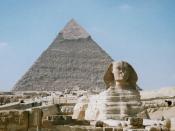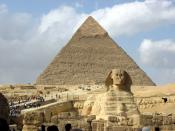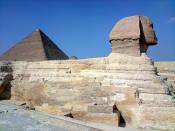The Great Sphinx at Giza in Egypt is the oldest monumental stone sculpture in the world, and still the largest. At 74m long by 20m high, not even Mt Rushmore (at a mere 18m) can compete. The mouth, with its enigmatic smile, caused by erosion and ancient vandalism rather than design, is 2 meters across. It was carved from the living rock - one of several limestone knolls in the area. The body, heavily eroded, is a soft yellowish limestone; the head is of a much harder grey limestone. It faces due east, directly at the sunrise at the solstice. The neck is particularly badly weathered, because it was vulnerable for the very long period when only the head was visible above the sand. Herodotus, who has much to say about the pyramids, does not mention the Sphinx at all - maybe it was completely buried in the 5th century BC.
The head and face (which once had a beard, fragments of which are in the British Museum) are typical of Dynasty IV, with its headdress (heavily restored in the 1920s), uraeus (cobra on the forehead), and red paint (which Pliny the Elder recorded in the 1st century AD as having religious significance), traces of which are still visible. Note that is very definitely male, and has no wings The Sphinx is certainly to be dated to within a few years of 2500 BC. The builder was most probably Khafre (who built the second largest of the three pyramids) or possibly his successor Menkaure. Unfortunately for the various gullible amateurs who would like to see it built by refugees from Atlantis or Martians 8000 years earlier in 10,500, the archaeological evidence clearly shows the sphinx enclosure was formed by the excavation of material (to create its paws and lower parts)...



Yeah
aaa
2 out of 4 people found this comment useful.